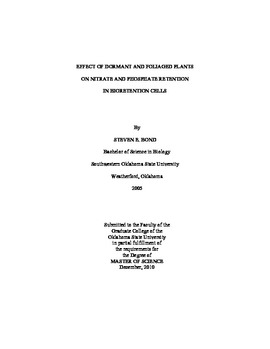| dc.contributor.advisor | Smolen, Michael D. | |
| dc.contributor.author | Bond, Steven E. | |
| dc.date.accessioned | 2014-04-15T22:31:34Z | |
| dc.date.available | 2014-04-15T22:31:34Z | |
| dc.date.issued | 2010-12-01 | |
| dc.identifier.uri | https://hdl.handle.net/11244/9544 | |
| dc.description.abstract | This study is an assessment of the effect of plants, vesicular arbuscular mycorrhizal fungi (VAM), and seasonality on Bioretention Cell performance. Performance was evaluated as retention of nitrate, ammonium, and phosphate during foliaged and dormant seasons. This study is intended to evaluate the significance of plant presence and VAM interaction in laboratory-scale Bioretention Cells by quantifying changes in effluent volume and nutrient concentration and load following two-liter applications of a synthetic stormwater (SSW) containing 2mg/L nitrate, ammonium, and phosphate (as N and P). Bioretention Cells were leached with deionized water (DI) for 33-weeks to bring leachate concentration below SSW levels. In week thirty-four SSW was added weekly for three weeks to each Bioretention cell while plants were dormant (12_Jan_08 through 2_Feb_08) and while plants were foliaged (19_Apr_08 through 10_May_08). Plants have a significant role in the process of bioretention. Vesicular arbuscular mycorrhizal fungi where not initially present in the roots of plants used for this study and failed to colonize the roots of these plants during this experiment, VAM was not significant in any of the results. Bioretention Cells with dormant and foliaged plants infiltrated and released effluent significantly faster than Bioretention Cells without plants. Foliaged plants significantly reduced total effluent volume. Very little ammonium was released by any Bioretention Cell, with or without plants. Dormant plants reduced effluent concentration and load of nitrates and phosphates relative to the SSW, but foliaged plants only reduced phosphates. Bioretention cells with foliaged plants increased nitrate concentration relative to SSW, but still significantly below that of Bioretention Cells without plants. Plants significantly influence infiltration rates, effluent concentration and loading of nitrates, phosphates, and ammonium; seasonality (plant dormancy/foliaged) significantly influences these results. | |
| dc.format | application/pdf | |
| dc.language | en_US | |
| dc.publisher | Oklahoma State University | |
| dc.rights | Copyright is held by the author who has granted the Oklahoma State University Library the non-exclusive right to share this material in its institutional repository. Contact Digital Library Services at lib-dls@okstate.edu or 405-744-9161 for the permission policy on the use, reproduction or distribution of this material. | |
| dc.title | Effect of Dormant and Foliaged Plants on Nitrate and Phosphate Retention in Bioretention Cells | |
| dc.type | text | |
| dc.contributor.committeeMember | Schnelle, Michael | |
| dc.contributor.committeeMember | John, Gilbert | |
| osu.filename | Bond_okstate_0664M_11222.pdf | |
| osu.college | Agricultural Sciences and Natural Resources | |
| osu.accesstype | Open Access | |
| dc.description.department | Environmental Sciences Program | |
| dc.type.genre | Thesis | |
